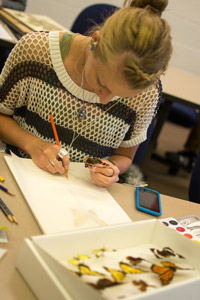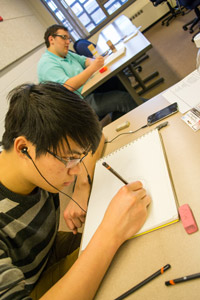Biological Illustration Course
Discovering an artistic approach to biology
June 7, 2013
By Jillian Birkholz '15
Inviting students to put down the scalpel and pick up the paintbrush, a course in the biology department at the College of Saint Benedict and Saint John's University blends art, science and service giving students the opportunity to produce biology-inspired artwork for clients.
 During the first six weeks of the course, Jim Poff -a CSB/SJU professor of biology- introduces students to different drawing techniques including graphite pencil, pen and ink, colored pencil, watercolor and carbon dust as well as practice working with Photoshop and Illustrator computer programs.
During the first six weeks of the course, Jim Poff -a CSB/SJU professor of biology- introduces students to different drawing techniques including graphite pencil, pen and ink, colored pencil, watercolor and carbon dust as well as practice working with Photoshop and Illustrator computer programs.
For the remainder of the course, the students work primarily with professors from the biology and environmental studies departments to create artwork for the professors' lab manuals and field guides. Clients for these projects may also include members of the community.
Reanna Nelson, who graduated from CSB in May with a degree in art, worked with Carol Jansky, the biology lab coordinator at CSB/ SJU, to create illustrations for her mink dissection guide.
"My favorite part of the course was getting to try out different mediums," Nelson said. "As an art major, I specialize in painting and felt stuck in oil painting and it was nice to get to experiment with different mediums."
Nelson will be teaching in South Korea and plans to apply to public health school upon her return. She gained knowledge from the course that will help her in her future endeavors.
"I looked into medical illustration and just wanted to try it out," Nelson said. "I'm definitely glad I took (the class). It's been a lot of work and it's been a great experience. I've really enjoyed learning more about the field.
"Though the course isn't directly related to my path, I think the interpersonal skills I learned through the assignments will be beneficial in my future," Nelson said.
Poff's personal interest in the field of biological illustration-and an interest in attracting those not majoring in biology to the department-inspired the creation of the course at CSB/SJU.
"My background is some training, classes and workshops in art, which weren't specifically biological art. And then I took a summer program in biological illustration through Cornell University," Poff said. "I did that primarily because of my interest in using the art as a way of engaging the non-majors in working on observation skills for the non-majors field biology class."
 Because of its artistic element, the course is appealing to non-majors, but it also offers biology students a non-traditional approach to the subject.
Because of its artistic element, the course is appealing to non-majors, but it also offers biology students a non-traditional approach to the subject.
"I was trying to find biology classes to sign up for for my major and I saw it and it looked really interesting," recalled Emelia Hauck, senior biology major. "I enjoyed art in middle school but they didn't offer it at my high school so I never really got to do it. So it was just something different within biology."
Poff encourages students to strengthen their observation skills and interact with the world in a more detail-oriented way.
"Just the idea of looking at something carefully and then taking what you've learned from that and applying it to the way you look at the world-there is a lot of detail out there and a lot of it is important and a lot of it is missed," Poff said. "So just being a better observer of nature is something that would be beneficial to just about anybody regardless of their vocation or specialization."
"I think trying to draw things this realistically makes you a better observer and more in-tune to detail and I think that's something you can apply to any subject," Nelson said. "Just being able to draw is a good skill to have even if you're going into something like advertising or marketing."
Hauck was even able to score a summer internship that may lead to a career with the skills she developed in the course.
"It did open doors for me because I was doing this project for William Lamberts [associate professor of biology at CSB/SJU] and I was drawing aquatic illustrations. I was able to get an aquatic plant internship with the Department of Natural Resources (DNR) in Brainerd, Minn., this summer," Hauck said. "I'm hoping that this DNR internship will lead to work in the DNR conservation. So this project is definitely helping with that."
Poff has taught the course twice and it will be offered again in spring of 2014.
"So far I've been really pleased with it. For the most part the students have had good attitudes and many of them are working well outside their comfort zones but they're sticking with it and I think overall the quality of the work has been really good," Poff said. "One of the things about being a faculty member and having students show their work is that some of the credit always bounces back to me and they've just done amazing stuff."
